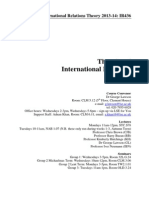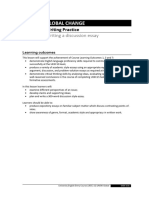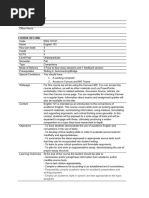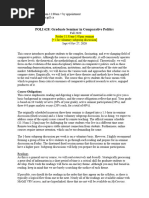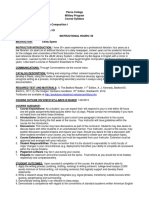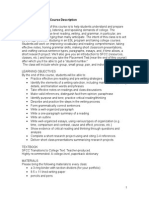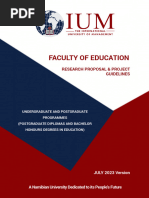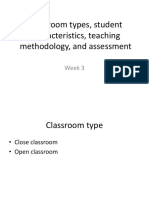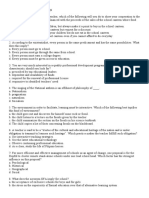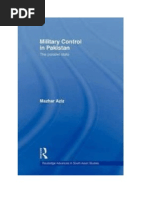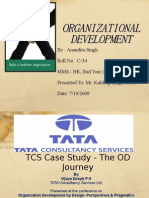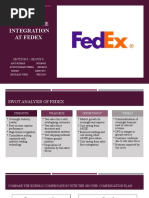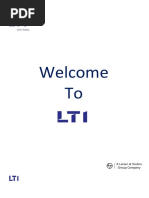BIBL2302 Hermeneutics Syllabus Cone
BIBL2302 Hermeneutics Syllabus Cone
Uploaded by
jeremeetylerCopyright:
Available Formats
BIBL2302 Hermeneutics Syllabus Cone
BIBL2302 Hermeneutics Syllabus Cone
Uploaded by
jeremeetylerOriginal Description:
Copyright
Available Formats
Share this document
Did you find this document useful?
Is this content inappropriate?
Copyright:
Available Formats
BIBL2302 Hermeneutics Syllabus Cone
BIBL2302 Hermeneutics Syllabus Cone
Uploaded by
jeremeetylerCopyright:
Available Formats
Syllabus BIBL2302 Hermeneutics Christopher Cone, Th.D, Ph.
D 07/13/10
I. Course Description:
Hermeneutics is the discipline (science & art) of Biblical interpretation. This course will cover introductory themes and processes of Biblical interpretation, and will compare and critique varying approaches and their significance toward understanding the Bible, understanding theology, and knowing God personally.
II. Course Objectives
1. To understand the basic approaches and development of various hermeneutic methods 2. To become thoroughly familiar with the exegetical use of the literal historical grammatical hermeneutic
process by applying the process to a Biblical passage
3. To gain a deeper knowledge of and fellowship with our Lord through a proper hermeneutic approach
III. Course Textbooks
Required Texts: Christopher Cone, Prolegomena on Biblical Hermeneutics and Method, 2 nd Ed., Tyndale Seminary Press, 2012, ISBN 978-1-938484-0302 (also available as ebook) Mal Couch, An Introduction to Classical Evangelical Hermeneutics , Kregel, 2000, 978-0825423673 Roy Zuck, Basic Bible Interpretation, David C. Cook, 1991, 0781438772 Robert Thomas, Evangelical Hermeneutics, Kregel, 2003, 978-0825438394 Recommended Texts for Additional Study: Bernard Ramm, Protestant Biblical Interpretation, Baker Book House, 1980, 978-0801020834 Paul Enns, Moody Handbook of Theology, Moody Press, 2008, 978-0802434340
IV. Evaluation of Student Performance
1. Class Attendance for Campus students, due to the concentrated nature of the lectures, one unexcused class absence will reduce final grade by a letter grade. A 2nd unexcused absence will result in an additional research assignment required for a passing grade. A 3rd unexcused absence will result in a failing grade. Online students must listen to the recorded lectures in their entirety and must fulfill all other format-specific requirements in order to receive a passing grade, including occasional interaction with the Advising Professor/Instructor. If the Online student is not responsive to Advising Professor/Instructor communication, the student may become inactive and receive a grade of incomplete on the course (I). Reading Assignments and Accountability Students will complete assigned reading and write a one-page summary highlighting key points of the reading. Research Assignments Students will write an exegesis paper, comprised of components learned in each class and a culminating exposition. All students will submit this work progressively as covered in classes 29. Campus students will write roughly 20 pages, while Online students will be expected to write roughly 15 pages. Course Exams There are no quizzes or exams for this course. Online Interaction Online students will have three online assignments each module: (1) email reading accountability to the Advising Professor/Instructor; (2) email a brief (50-75 words) observation of a key point from that modules lecture; and (3) respond to Advising Professor/Instructor questions and observations. Campus students will submit assignments as directed by the Professor. Online Students will submit assignments directly to Advising Professor/ Instructor .
2. 3.
4. 5.
6.
7.
V. Course Outline & Assignments
Class 1 Introduction Class 2 Verify Text & Translation
Scoring Rubric Assignments Campus Attendance or Online Participation Pass/Fail/Reduction Reading Component (Reading & Accountability) 30 (40 if no exams) Research Component (Papers & Projects) 40 (60 if no exams) Exam Component (if applicable) 30 (if applicable) Total Points: 100
Online 25 25 25 (50 if no exams) 25 (if applicable) 100
Reading Component Cone, 268-274; Zuck, 27-58; Couch, 11-30; Write a one-page summary of the readings. Research Component Section #1. Preliminary Passage Overview (2 pages) : a.Choose between any of the following passages: Ephesians 4:1-16; Philippians 2:1-11; Revelation 20:1-6; Psalm 2; Haggai 2:1-9 b.Study the passage in four different translations and identify and key differences or issues in the translations. Note variants. c.Write your passage overview identifying the following elements: 1.Identify variants in the text 2.Briefly summarize the passage 3.Summarize your current understanding of the theological impact of the passage 4.Identify doctrinal presuppositions you have in approaching the passage Class 3 Understand Background & Context Reading Component Cone, 275-277; Zuck, 58-75; Write a one-page summary of the readings. Research Component Section #2. Background/Context Summary (2 pages) a.Identify, defend, and explain the significance of literary form/genre (prophecy, historical narrative, epistle, poetic) b.Research key questions regarding the background of the book (authorship, composition, purpose, etc.) c.Summarize background and context highlighting the following elements: historical, social, geographical, authorship, date, literary form. d.Identify how these findings are significant to interpretation of the passage Class 4 Identify Structure Reading Component Cone, 277-278; Zuck, 76-97; Thomas, 141-164. Write a one-page summary of the readings. Research Component Section #3. Outline/Structural Summary (2 pages) a.Outline the book, identifying major and minor divisions b.Identify structural keys/developments (development of narrative, development of argument, chiasm, etc.) c.Identify the importance of the structure in the interpretation of the passage Class 5 Identify Grammatical & Lexical Keys Reading Component Cone, 278-282; Zuck, 123-142; Couch, 32-51; Write a one-page summary of the readings. Research Component Section #4 & 5 Grammatical Summary (1-2 pages) Lexical Summary (1-2 pages) Grammatical Summary (1-2 pages) a.Identify historical/cultural references, figurative language, rhetorical devices, quotations, etc b.Identify key sentence structure, clauses, etc. c. Summarize the importance of these grammatical keys to the interpretation of the passage Lexical Summary (1-2 pages) a.Identify key words b.Do a full word study on at least one key word in the passage c.Summarize key concepts arising from key words
Class 6 Identify Biblical Context Reading Component Cone, 282-284; Zuck, 143-168; Thomas, 241-270; Write a one-page summary of the readings. Research Component Section #6. Biblical Context Summary (2 pages) a.Briefly identify the theme of the book b.Summarize the immediate context surrounding the passage c.Summarize how the passage contributes to the overall theme of the book Class 7 Identify Theological Context Reading Component Cone, 284-286; Zuck, 169-193; Couch, 52-70; Write a one-page summary of the readings. Research Component Section #7. Theological Context Summary (2 pages) a.Identify theological principles in the passage b.Connect the principles to the overall context of the book c.Summarize theological themes based on context Class 8 Secondary Verification Reading Component Cone, 286-288; Zuck, 194-226; Write a one-page summary of the readings. Research Component Section #8. Correlation Summary (2 pages) a.Utilize five commentaries covering the passage b.Identify hermeneutic method of the commentators c.Summarize agreements & differences in the interpretations of the commentators d.Defend your interpretation or alter it in light of your findings. Class 9 Exposition Reading Component Cone, 288-291; Zuck, 227-249; Write a one-page summary of the readings. Research Component Section #9. Analysis & Impact (3-5 pages) a.Provide verse analysis - running commentary on the passage b.Summarize principle, primary application, & secondary application c.Identify the impact of the passage on your own life
VI. Tyndale General Policies and Procedures
Assignment Format All assignments and coursework are to be turned in via student Tyndale email. Students are not required to turn in assignments in hard copy. Students must send any required notes, questions, papers, etc. via email as separate attachments in .doc, docx, or pdf format. Coursework should be submitted directly to the Professor/Instructor (for Campus and Learning Center students) or to the Advising Professor/Instructor (for Online students). The subject line for all submitted coursework should be formatted as follows to ensure receipt of the material: Campus Students: Learning Center Students: Online Students: Professor Name, Class # & Name, Student Name, Assignment Title
(e.g.: C, Johnson, BIBL2301 Hermeneutics, Smith, Paper #1)
LC Location, Campus Prof. Name, Class # & Name, Student Name
(e.g.: Mason, Johnson, BIBL2301 Hermeneutics, Smith)
Online Prof. Name, Class # & Name, Student Name, Assignment Title
(e.g.: O, Johnson, BIBL2301 Hermeneutics, Smith, Paper #1)
Electronically submitted coursework will be returned along with a final grade via email after the course has been graded.
Assignment Due Dates Campus/Learning Center students will submit all assignments according to the schedule as outlined in the syllabus. Final assignments are to be submitted no later than the last class period of the semester. Online students will submit all assignments at their own pace, but must maintain interaction with Advising Professor/Instructor throughout the duration of the course. Writing Guidelines All research papers and theses are to follow Turabian guidelines as found in Kate L. Turabian A Manual for Writers of Term Papers, Theses, and Dissertations 7th Ed. (Chicago: University of Chicago Press, 2007). All students are required to purchase a copy of A Manual for Writers to ensure the proper format. All work is to follow these guidelines: 1. Font & Font Size: Times New Roman, 12 point 2. Double space 3. 1-inch margins (File Page Setup Margins) 4. Indent paragraphs .5 inch (Format Paragraph Indent left) 5. Page numbers lower center or upper right beginning with the first page of text, but not on title page; Arabic numbers only (e.g., 1, 2; not Roman numerals); no other header or footer 6. Title page; then title again on page one (for formal papers) 7. In essay-type papers, ALWAYS write logically, persuasively, focused on the assigned topic; include a succinct introduction that informs the reader concerning the subject of your paper, and a succinct conclusion that summarizes your main points and expresses your resulting conclusion. 8. Use footnotes rather than endnotes, except in dissertation/thesis, where section endnotes are also acceptable. 9. All work should be proofread, as errors in spelling, grammar, and syntax will reduce assignment grade. Plagiarism Policy Plagiarism is against Tyndale policy, and any act of plagiarism will result in disciplinary action up to student dismissal from further study at Tyndale. Plagiarism includes but is not limited to quoting materials without proper citing or reference. Cutting and pasting of online and other materials requires proper citing via quotation marks and footnote. Contact If you anticipate difficulty in meeting any of these requirements, please contact your Professor (for Campus/Learning Center students) or your Advising Professor/Instructor (Online students) as soon as possible. A complete review of all Tyndale policies and procedures can be found in the Tyndale Theological Seminary and Biblical Institute Academic Catalog.
You might also like
- ENGL 112 Syllabus (Fall 2021)Document7 pagesENGL 112 Syllabus (Fall 2021)Adan SaeedNo ratings yet
- Preparing For Success in Primary and Lower Secondary Global PerspectivesDocument46 pagesPreparing For Success in Primary and Lower Secondary Global PerspectivesSuchandra Lahiri100% (1)
- Grade 8 QuestionnaireDocument7 pagesGrade 8 QuestionnaireKay Tracey Urbiztondo50% (10)
- Syllabus HSM 300 1 2Document21 pagesSyllabus HSM 300 1 2api-315592986No ratings yet
- jiDocument9 pagesjilediy80483No ratings yet
- Theory of International RelationsDocument30 pagesTheory of International RelationsRenato Ribeiro100% (1)
- Simon Rippon's Office: D410: Course DescriptionDocument7 pagesSimon Rippon's Office: D410: Course DescriptionyoungNo ratings yet
- I R 436 Reading ListDocument29 pagesI R 436 Reading ListReiñer SubijanoNo ratings yet
- syllabus PHIL 4P20 Kant winter 2025Document9 pagessyllabus PHIL 4P20 Kant winter 2025reborndoughnutNo ratings yet
- HON 101F Fall 2021Document8 pagesHON 101F Fall 2021bobbyNo ratings yet
- Phil 243 Syllabus - Day - Fall 2023Document8 pagesPhil 243 Syllabus - Day - Fall 2023tunaakiNo ratings yet
- NBST515 8wk SyllabusDocument5 pagesNBST515 8wk SyllabusLauren HudnallNo ratings yet
- ReadingsDocument8 pagesReadingsTea DžoniNo ratings yet
- UT Dallas Syllabus For Hist4359.001.07f Taught by Monica Rankin (Mar046000)Document12 pagesUT Dallas Syllabus For Hist4359.001.07f Taught by Monica Rankin (Mar046000)UT Dallas Provost's Technology GroupNo ratings yet
- Course Name: Graduate Seminar II Course Code: CR HRS: 2 Instructor: Dawit Amogne Course DescriptionDocument3 pagesCourse Name: Graduate Seminar II Course Code: CR HRS: 2 Instructor: Dawit Amogne Course DescriptionDAWIT AMOGNENo ratings yet
- Katzenstein - Intro To IR, Cornell PDFDocument6 pagesKatzenstein - Intro To IR, Cornell PDFdcter2288No ratings yet
- Church History 3Document4 pagesChurch History 3paulropan1No ratings yet
- U15 U3 WP 250220 FillDocument4 pagesU15 U3 WP 250220 Fillqq2906663925No ratings yet
- Analytical ReadingDocument11 pagesAnalytical Readinganon-579447No ratings yet
- Module 3 Communication For Academic Purposes EDITEDDocument29 pagesModule 3 Communication For Academic Purposes EDITEDColor Red0% (1)
- International RelationDocument31 pagesInternational RelationRenz Jerome CabreraNo ratings yet
- Course Syllabus Fall 2023 RevisedDocument22 pagesCourse Syllabus Fall 2023 RevisedrayNo ratings yet
- Barth SylabbusDocument0 pagesBarth SylabbusBogdan DanNo ratings yet
- 3.6.2 Reference 27. OT 9131 Daniel Syllabus PDFDocument12 pages3.6.2 Reference 27. OT 9131 Daniel Syllabus PDFEmmanuelNo ratings yet
- Writing - Thesis Guide For MA Studentsthe ProcessDocument10 pagesWriting - Thesis Guide For MA Studentsthe Processjosajibi10No ratings yet
- in Comparative politicsDocument9 pagesin Comparative politicshiyyx7No ratings yet
- Cs 101 Chapter 1 PackageDocument7 pagesCs 101 Chapter 1 PackageColias DubeNo ratings yet
- Bio 3224 F OutlineDocument12 pagesBio 3224 F OutlineHungNo ratings yet
- Utp MPW 2153 - Moral Studies (Assignment Format)Document5 pagesUtp MPW 2153 - Moral Studies (Assignment Format)Alan A. AlexanderNo ratings yet
- 23-24-1 ENG 102 Common SyllabusDocument10 pages23-24-1 ENG 102 Common Syllabuscavit.ergul.42No ratings yet
- 100 Syllabus Fall 23Document7 pages100 Syllabus Fall 23harsheetslietNo ratings yet
- Engl&101 English Composition I Syllabus Rev. 11-12Document6 pagesEngl&101 English Composition I Syllabus Rev. 11-12dannyf09No ratings yet
- Syllabus Fall 2021 Murphy Version 2Document8 pagesSyllabus Fall 2021 Murphy Version 2Emmy CiraNo ratings yet
- Models and Strategies of TeachingDocument10 pagesModels and Strategies of TeachingivanNo ratings yet
- Research Methodology 1Document31 pagesResearch Methodology 1sekaniphiri702No ratings yet
- English 102 Rhetoric and Composition Bulletin Information Course DescriptionDocument8 pagesEnglish 102 Rhetoric and Composition Bulletin Information Course DescriptionShahadat HossainNo ratings yet
- M-BS2210 Old Testament Survey IDocument8 pagesM-BS2210 Old Testament Survey Ilediy80483No ratings yet
- CS131 Study Pack 1 2021Document32 pagesCS131 Study Pack 1 2021Mandisa MonarengNo ratings yet
- ESL TRANSITIONS: Course DescriptionDocument5 pagesESL TRANSITIONS: Course Descriptionʚϊɞ Sarah Omar ʚϊɞNo ratings yet
- Slaughterhouse-Five Learning SegmentDocument20 pagesSlaughterhouse-Five Learning Segmentapi-316626434No ratings yet
- Assignment Brief Only For TEAP 2021-22Document14 pagesAssignment Brief Only For TEAP 2021-22Ynt NwNo ratings yet
- Master'S Project Seminar: Inquiry, Designs, and Methods Education 409Document6 pagesMaster'S Project Seminar: Inquiry, Designs, and Methods Education 409YunranNo ratings yet
- THEO525 8WK SyllabusDocument4 pagesTHEO525 8WK SyllabusLaurie PelosiNo ratings yet
- Syllabus 793Document5 pagesSyllabus 793Jemma GandaNo ratings yet
- Expository PreachingDocument2 pagesExpository PreachingCrys TalaNo ratings yet
- Learning Segment Template: Fahrenheit 451Document17 pagesLearning Segment Template: Fahrenheit 451api-317151718No ratings yet
- Term Paper GuidelinesDocument3 pagesTerm Paper GuidelinesKenji RequirmanNo ratings yet
- Education Research GuidelinesDocument22 pagesEducation Research GuidelinesEven DkNo ratings yet
- English For Academic Purposes II: RevisedDocument6 pagesEnglish For Academic Purposes II: RevisedAryaNo ratings yet
- Syllabus NMP 2011Document10 pagesSyllabus NMP 2011Buzneri AlexandraNo ratings yet
- BISA 401 Assessment Brief - 2023 2Document4 pagesBISA 401 Assessment Brief - 2023 2Ubaid RehmanNo ratings yet
- NGRK505 SyllabusDocument6 pagesNGRK505 SyllabusJames YoonNo ratings yet
- Eng 101 Intro To College Writing Syllabus Fall 2023Document7 pagesEng 101 Intro To College Writing Syllabus Fall 2023api-643167405No ratings yet
- Writing at Masters LevelDocument20 pagesWriting at Masters Levelnirajthurai100% (2)
- UT Dallas Syllabus For Rhet1302.029 06f Taught by Sarah Bowman (slb026000)Document15 pagesUT Dallas Syllabus For Rhet1302.029 06f Taught by Sarah Bowman (slb026000)UT Dallas Provost's Technology GroupNo ratings yet
- PSYC305 SyllabusDocument8 pagesPSYC305 SyllabusAlex MunozNo ratings yet
- LEC 101 PhillipsDocument9 pagesLEC 101 Phillipscolehyatt5No ratings yet
- ENG 151-4 Fall 2021 SyllabusDocument7 pagesENG 151-4 Fall 2021 SyllabusPj TuavaoNo ratings yet
- Final May 1 2024 Task On Reading Writing ClassDocument8 pagesFinal May 1 2024 Task On Reading Writing Classspotifyej242007No ratings yet
- LSGI1D03 EWR Assignment Guidelines 2019-20 Sem 1Document4 pagesLSGI1D03 EWR Assignment Guidelines 2019-20 Sem 1Ma Chung WaiNo ratings yet
- Midterm ReviewDocument2 pagesMidterm ReviewENo ratings yet
- Cape Communication Studies: Practical Exercises for Paper 02 EssaysFrom EverandCape Communication Studies: Practical Exercises for Paper 02 EssaysNo ratings yet
- #La411 ListingsDocument10 pages#La411 ListingsjeremeetylerNo ratings yet
- PDX, Or. - Seattle, Wa. Prod. CompaniesDocument2 pagesPDX, Or. - Seattle, Wa. Prod. CompaniesjeremeetylerNo ratings yet
- #La411 ListingsDocument10 pages#La411 ListingsjeremeetylerNo ratings yet
- Tyndale 2013-2014 #CatalogDocument73 pagesTyndale 2013-2014 #CatalogjeremeetylerNo ratings yet
- Group 5 - BSE Math II-2 - InfographicDocument1 pageGroup 5 - BSE Math II-2 - InfographicBon Jaime TangcoNo ratings yet
- Winning Whip SpeechesDocument7 pagesWinning Whip SpeechesAnonymous PR78WYhfDNo ratings yet
- ProdevDocument75 pagesProdevBella LestariNo ratings yet
- My Culture BoxDocument9 pagesMy Culture BoxMichael McclanathanNo ratings yet
- MECH 488L: Capstone Design: NotesDocument1 pageMECH 488L: Capstone Design: NoteswalterbircherNo ratings yet
- Failure To Learn From Safety Incidents - Status, Challenges and OpportunitiesDocument13 pagesFailure To Learn From Safety Incidents - Status, Challenges and OpportunitiesEmy Ariviana100% (2)
- Savitribai Phule Pune University: Application For EligibilityDocument4 pagesSavitribai Phule Pune University: Application For EligibilitySandeep JoshiNo ratings yet
- Art 9 - Accountability of Public OfficersDocument43 pagesArt 9 - Accountability of Public OfficersRoel Marcial100% (1)
- MiniProjectLogBookGroup No 40Document14 pagesMiniProjectLogBookGroup No 40Linisha Bhansali100% (1)
- Capstone Project Proposal - Open Banking - Are We ReadyDocument11 pagesCapstone Project Proposal - Open Banking - Are We ReadyWendelynn Giannina AngNo ratings yet
- YMCA KL New Building - Fundraising Portfolio - Compact New IIDocument35 pagesYMCA KL New Building - Fundraising Portfolio - Compact New IIYMCA of Kuala LumpurNo ratings yet
- University of The Philippines System Codified Rules For Student Regent SelectionDocument9 pagesUniversity of The Philippines System Codified Rules For Student Regent SelectionRey Malvin SG PallominaNo ratings yet
- Chapter 2: Overview of Mercantile Bank Ltd. (MBL)Document13 pagesChapter 2: Overview of Mercantile Bank Ltd. (MBL)angelNo ratings yet
- Case Study 2Document30 pagesCase Study 2Narasimha Murthy H NNo ratings yet
- NEET-MDS 2021 SekharDocument5 pagesNEET-MDS 2021 SekharSai KarthikNo ratings yet
- Department of Education: Assessment and Selection Report On The Engagement of Services of Learning Support AidesDocument2 pagesDepartment of Education: Assessment and Selection Report On The Engagement of Services of Learning Support AidesMichelle Fuentes VillosoNo ratings yet
- Review Article: ISSN: 0975-833XDocument5 pagesReview Article: ISSN: 0975-833XArchiesivan22No ratings yet
- Reviewer 2 (2022)Document24 pagesReviewer 2 (2022)Sonia Claire C. Lazatin100% (1)
- Military Control in Pakistan-The Parallel State, Mazhar AzizDocument6 pagesMilitary Control in Pakistan-The Parallel State, Mazhar AzizStrategicus Publications100% (1)
- UPDATED COLLEGE SCHEDULE 1ST SEM 2020-2021 As of September 17, 2020 FROM DR. DEJARMEDocument19 pagesUPDATED COLLEGE SCHEDULE 1ST SEM 2020-2021 As of September 17, 2020 FROM DR. DEJARMEBenjamin Fernandez Jr.No ratings yet
- Organizational Development in TCSDocument39 pagesOrganizational Development in TCSanandita2888% (17)
- Sales Force Integration at Fedex: Section I - Group 8Document6 pagesSales Force Integration at Fedex: Section I - Group 8Anuj ChoutalaNo ratings yet
- College Reading Upper-Intermediate Level: Lesson ThreeDocument13 pagesCollege Reading Upper-Intermediate Level: Lesson ThreeErdenebulgan BatkhulegNo ratings yet
- Nestle USA - ERP ImplementationDocument11 pagesNestle USA - ERP Implementationpujithamuramalla50% (2)
- TUTORIAL 3 (Questions) Q1: UKAT3033/UBAT3033 Taxation IIDocument2 pagesTUTORIAL 3 (Questions) Q1: UKAT3033/UBAT3033 Taxation IIIzaac PovanesNo ratings yet
- Welcome To: !!! Me To LTI !!! Me To LTI !!!Document6 pagesWelcome To: !!! Me To LTI !!! Me To LTI !!!Saurabh KothariNo ratings yet
- 801 Article Critique Graviles, Glyziel Anne P.Document2 pages801 Article Critique Graviles, Glyziel Anne P.Glyziel Anne GravilesNo ratings yet







